Scales and Feathers
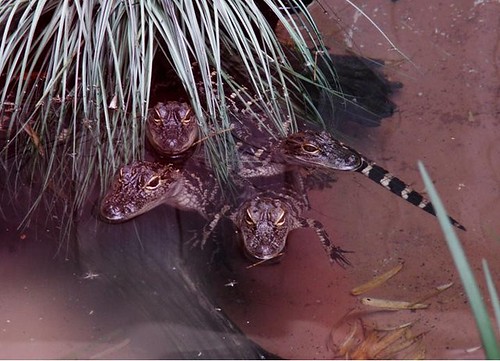
American alligator hatchlings
A continuation of photos and commentary -- and video! -- from our St. Augustine trip. The next however-many installments describe the St. Augustine Alligator Farm and Zoological Park....
For folks on dial-up: There's a trick to viewing the video below without it stopping every other second -- at least it's worked for me. Go down to the video link before you continue reading this entry and click the Play button, followed immediately by the Pause button. The downloading will continue while you're reading. By the time you reach the video it should be able to play more than a brief burp.
(We now return you to your regularly-scheduled blog.)
Among the souvenirs we bought were copies of William R. Adams and Carl Shiver's fascinating The St. Augustine Alligator Farm: A Complete History. My historical information here is drawn from that book.
The farm's evolution is tied intimately to that of St. Augustine (founded in 1565) and Florida as a whole (named by Ponce de Leon, who reached its shores in 1513). The farm's establishment in 1893 occurred six years after the railroad had come to the city, improving accessibility to the rest of the eastern seaboard. While Florida was still mostly forests and jungles populated by strange tropical creatures unknown to folks up north, oil entrepreneur Henry Flagler began building hotels and advertising St. Augustine as a winter resort.
The South Beach Railway, a mule-drawn tram line, crossed the inter-coastal waterway from downtown St. Augustine onto Anastasia Island. To attract visitors to South Beach, an attraction was sought for the end of the line. A museum of marine curiosities served as precursor to the Alligator Farm. Everett C. Whitney's "Burning Spring Museum" -- a curiosity and souvenir shop with an artesian well whose sulfuric water was mixed with gasoline and ignited -- also included alligators on display, which had been collected on the island.
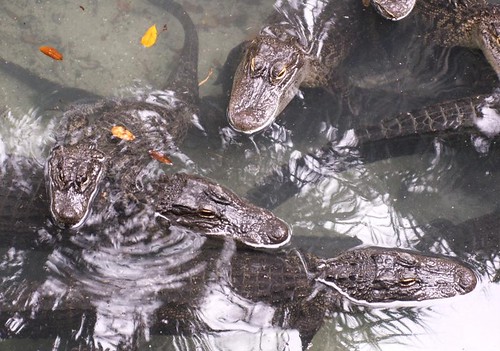
This huge pool of American alligators (Alligator mississippiensis) -- dozens of them -- was visible from the snack stand and bordered the "Reptile Theater," which left me with images of these guys dressing up and putting on a performance of King Lear.
The first mention of animals other than alligators at the farm appeared in the 1911 St. Augustine, St. Johns County Illustrated. That publication described the farm as offering a "complete collection" of deadly snakes found in Florida and animals from many parts of the state.
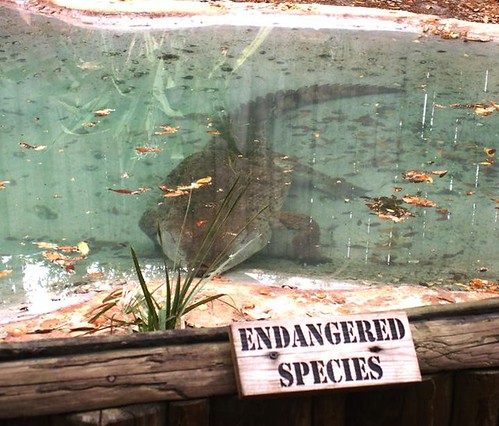
Orinoco crocodile
Upon the farm's incorporation in 1909, then-owners George Reddington and Felix Fire transferred to it their own collections of stuffed birds. Live ostriches followed in the 1920s, during which time the farm's name was changed to the St Augustine Ostrich-Alligator Farm & Museum of Marine Curiosities. After W.F. Drysdale and F. Charles Ursina purchased the attraction in 1937, they acquired more animals from other collections, including crocodiles, Galapagos turtles, and many different species of monkeys and birds.
According to the park's plaque, the South American Orinoco (Crocodylus intermedius) is one of the largest crocodilian species, historically reaching lengths of 20 feet, though specimens over 15 feet would be rare. Its habitat is freshwater rivers of the middle and lower Orinoco river basin and seasonal rivers created by flooding. It will seek out burrows along the riverbank during the dry season.
Over-hunting in the mid 20th century decimated the wild population of this species, currently estimated at fewer than 250 adults, with populations continuing to decline. It is legally protected in Columbia and Venezuela, although poaching by fishermen is reported to occur. Captive breeding farms for release programs have had some success in recent years.
The video below is my first attempt at embedding from You Tube. If the embedding here doesn't work, you can go directly to the URL by clicking on the title link.
Title Link: Alligator Mosey -- 22 seconds, approx. 11.5 MB.
I've uploaded three other videos as well, which I'll embed/link here when I post photos from the rookery. Or click on the title link and then on "ejourneys's Videos."
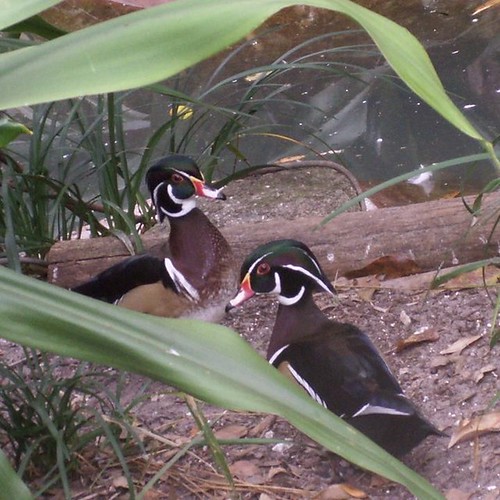
The farm is home to both common and endangered species. These North American Wood Ducks (Aix sponsa) shared living quarters with the black swan below.
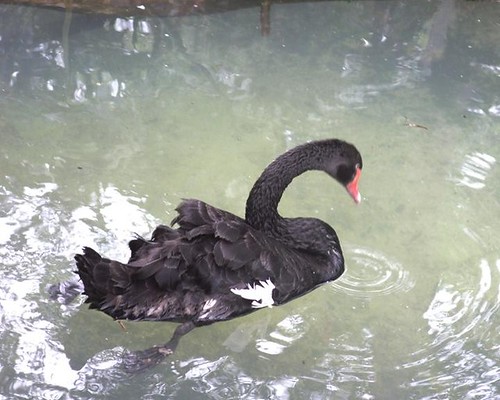
This species (Cygnus atratus) hails from Australia, and lives across the walk from the black-necked swans.

Cygnus melancorphus, a South American species.
After World War I the farm's clientele changed. St. Augustine and Florida as a whole shifted from a winter getaway for the rich to a real estate opportunity for the middle class, fueled by returning veterans who had been stationed near St. Augustine. "By the mid-1920s nearly twenty-five trains were arriving daily in Jacksonville," write Adams and Shiver. "The Jacksonville Chamber of Commerce reported in 1924 that 150,000 automobiles passed through the city during the winter season. An estimated 20,000 immigrants from other parts of the nation entered the state every day."
The attraction Drysdale and Ursina purchased in 1937 "consisted of a wood frame building containing offices, a gift shop, and the entrance to the exhibits. There were also the alligator pens that held an unknown number of reptiles, additional animal and bird displays, and several acres of undeveloped land."
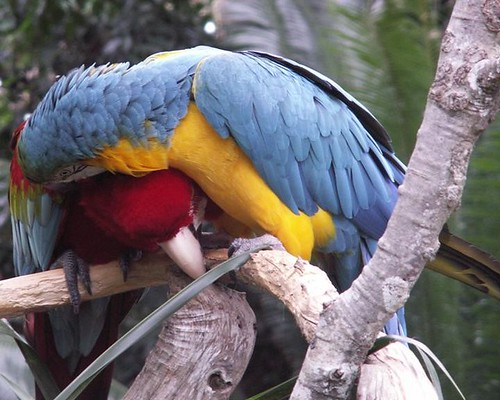
Parrots also populated this part of the park. Each had its own perch, but sometimes one would pay another a visit.
From reading the history I got the feeling the Great Depression had not been at the forefront of the farm's problems. The attraction Drysdale and Ursina bought had been moved from its original site to the one where it stands today. Hastily constructed in the 1890s, the farm's original buildings had suffered from wear and beach erosion. A year after a "nor'easter" knocked out the railway tracks in 1920, two separate fires destroyed most of the buildings. A summer storm then washed away the remains. Fortunately, the farm and its animals were already in the process of being relocated to the farm's current location.
Shortly after Drysdale and Ursina made their purchase, "a fire of unknown origin destroyed the main building of the complex. The new owners now had to worry about financing construction of a building to replace the one that had been razed by the flames, in addition to paying for the attraction's purchase cost.... Within three months, they announced plans for the construction of a new building that would contain offices, a taxidermy shop, gift store, and the entrance to the attraction. The orientation of the building was changed" to face what is now A1A, "the principal coastal highway along the state's eastern coast."
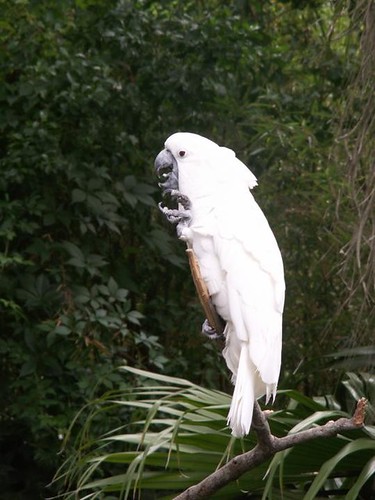
Cockatoo
Drysdale's son, David C. Drysdale, has owned the facility since the 1970s. Back then, alligators were beginning to rebound from the brink of extinction and scientists from the University of Florida came to the grounds to research them. "The American Association of Zoological Parks and Aquariums extended accreditation to the St. Augustine Alligator Farm in 1988, elevating the institution to a select list of zoological institutions throughout the United States that are recognized for the quality of their collections and the care they give them."
The exhibits represented by the photos above just scratch the surface. Much more to come....











1 Comments:
Fabulous farm! I'm loving the colours and intensities of the crocs and birds in your photographs. The video loaded fine - I have 'ultra lite high speed' which is I think slower than dial-up, anyhow another trick I use is to turn the sound off while it loads. You ought to try Google's service, I was amazed at the quality of the clip they uploaded - the sound was actually better than what Kodak delivered on my computer! And at normal size, the image was crystal clear. I wasn't able to upload to UTube, probably my older Mac operating system, so can't compare.
Post a Comment
<< Home